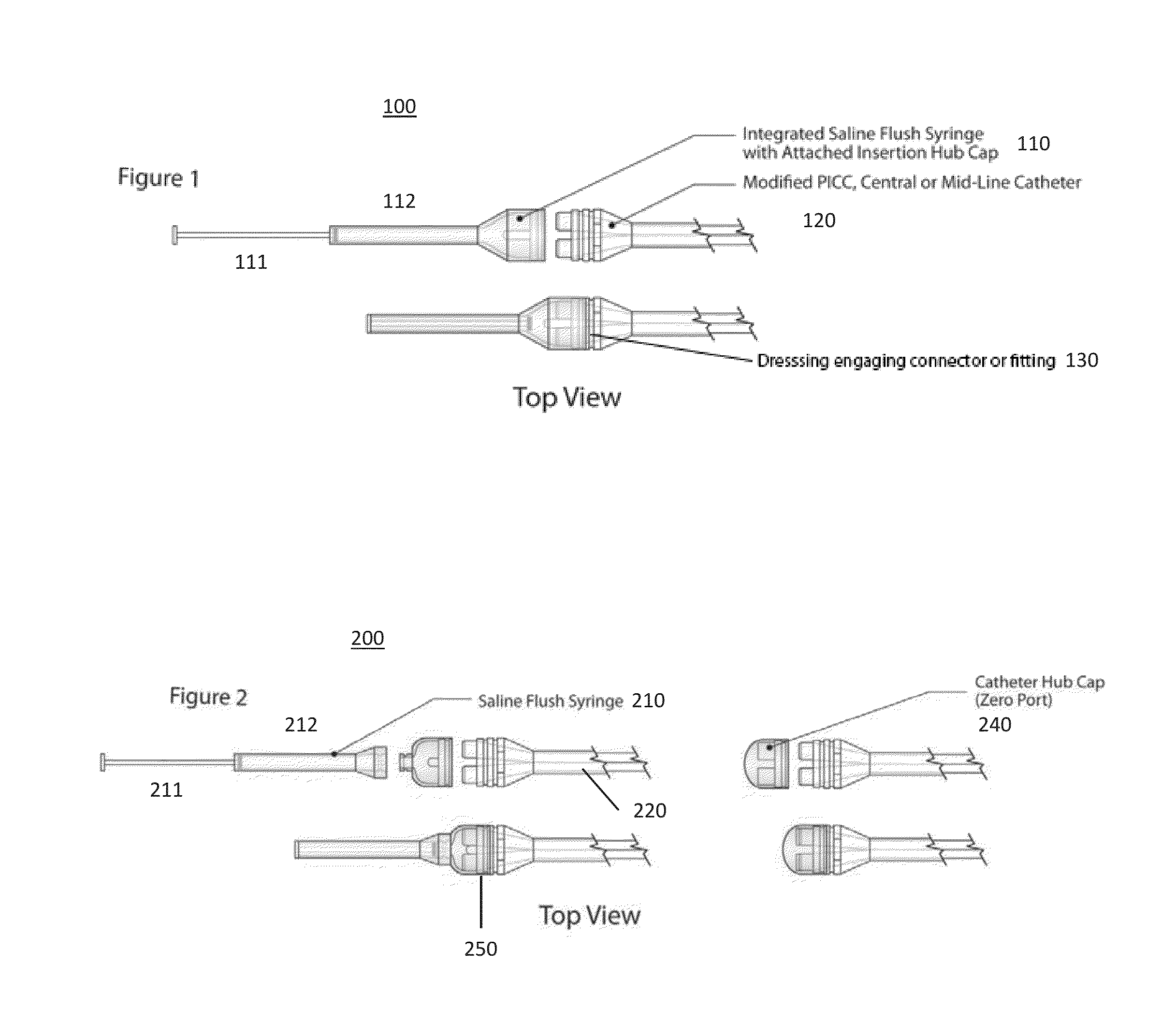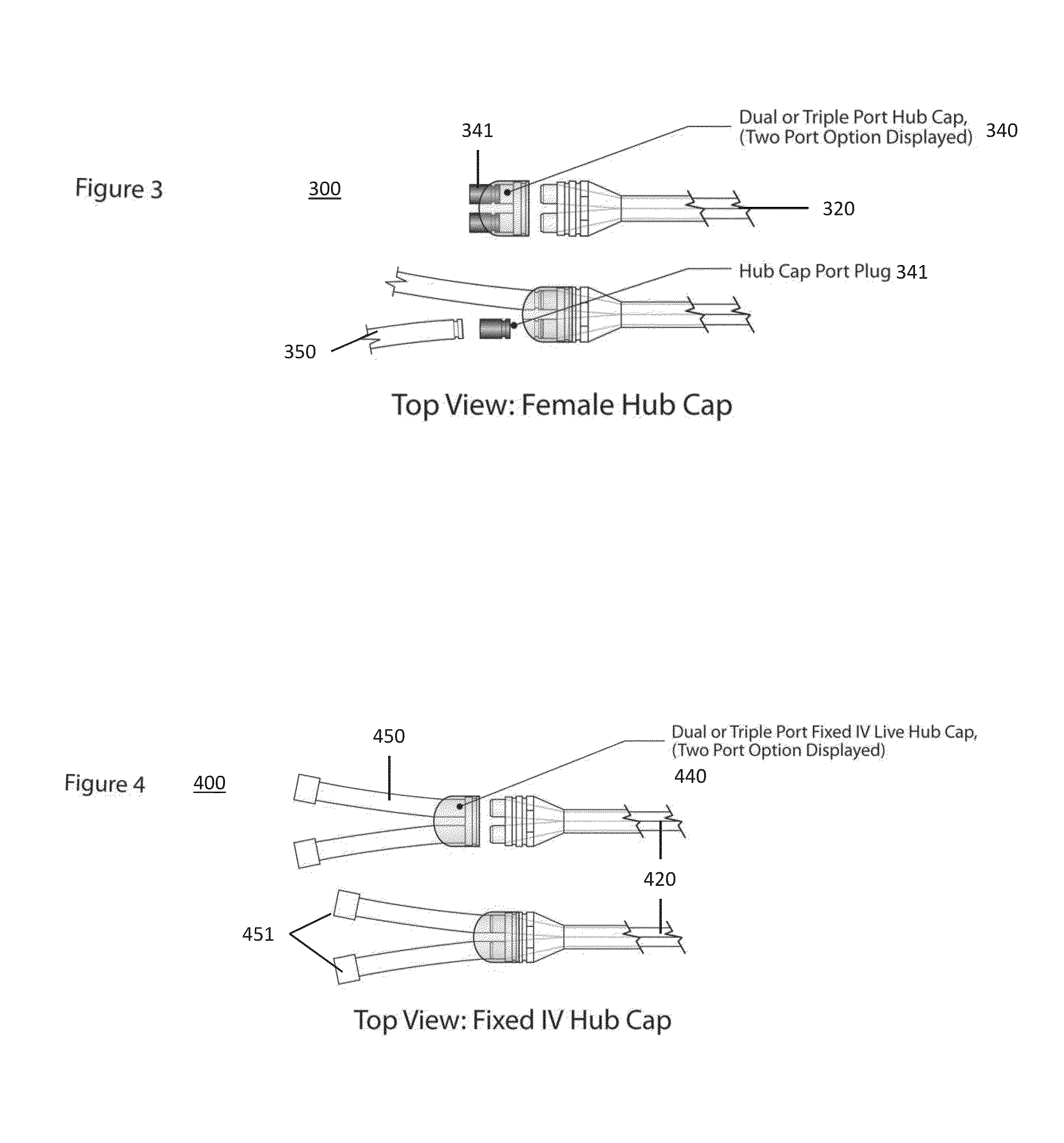Such catheters are inserted surgically in the operating room, and carry a unique level of complexity and invasiveness.
The healthcare
system has come under increasing scrutiny.
Even with these efforts, long term catheter infection and loss continues.
Such adverse catheter related events have been estimated to lead to the loss of 30,000 lives per year in the US alone, with costs reaching as high as 2.8 billion dollars.
First, and one of the primary faults / deficiencies with current CPMs, is the simple fact that the
catheter insertion site is not sealed and protected from the outside world.
Adjunctive stabilization devices such as Statlock®, meant to stabilize and help secure the catheter, unfortunately serve to affect additional dressing tenting, and provide many non-sterile
dead space areas / pockets for
bacteria and other contaminants exist / propagate.
Again, any movement of the catheter and / or catheter dressing serves to further loosen the
patch type dressing, increasing the potential for
contamination.
And because of its non-sealing structure, current catheter-dressing technology cannot be exposed to water, hindering showering and other patient hygienic activity without costly and
time consuming additional care maneuvers (e.g. covering the extremity / area with plastic and tape).
All lead to significant cost in respect to patient dissatisfaction.
In an attempt to counter the increased infectious risk associated with the use of current
patch type “open” dressing technology, which allows influx of contaminants beneath the dressing, dressing adjuncts have necessarily been developed (e.g. Biopatch®, antibiotic impregnated dressings and catheters), but these are costly, and, perhaps more important, run the very real risk of further selecting out multi-
drug resistant organisms (“super bugs”) through the “
blanket” systematic
antimicrobial use.
Second, existing PICC mid and
central line catheter and catheter dressing technology does not fully secure and stabilize the
vascular catheter, leading to vessel trauma (e.g.
thrombophlebitis) and premature catheter loss / dislodgement.
The suturing of long dwell time catheters has several drawbacks, including: (1) multiple
skin barrier breakpoints with quickly colonized suture material (e.g. silk), (2) pain (during placement, dwell, and removal), (3) localized
skin necrosis, (4) long term scarring, (5) additional tenting upward of the patch-type dressing and creation of persistent colonized skin penetrating pockets of
contamination.
Drawbacks to the use of external supplemental stabilization devices (e.g. Statlock®) include: (1) the additional complexity that is added to the
catheter insertion-dressing placement process, (2) additional cost, (3) additional
adhesive surface area (patient discomfort), (4) additional catheter-dressing bulk, (5) additional tenting upward of the
patch type dressing, (6) creation of multiple non-sterile areas beneath the tented up dressing, (7) and securement site relatively remote (upstream) from the catheter-skin
insertion site, allowing for movement of the catheter between the stabilization site and the
insertion site.
With current stabilization technology there remains the potential for catheter dislodgement, as the
catheter hub is not stabilized immediately adjacent to the insertion site.
Third, because of the non-sealing structure of existing PICC mid and
central line catheter dressing technology, and the obligatory bacterial and non-bacterial contamination that universally occurs, dressing changes must be performed at specified intervals.
Access to the catheter is not possible for insertion site care without removing the entire dressing and its large surface area.
This process has several drawbacks: (1) the entire dressing must be removed as there is no other way to access the insertion site (consumption of caregiver time), (2) removal of the full adhesive surface area of the dressing can be difficult /
time consuming as the adhesive often stuck to the catheter and its securement device, (3) this removal is painful / uncomfortable for the patient, (4)
high complexity of the
dressing change procedure (difficult for patients themselves to adequately perform), (5) the complex catheter / stabilization device surface cannot be rendered sterile once initially colonized by outside contamination, (6) the required
high frequency of dressing changes results in relative high hospital / caregiver inefficiency, and (7) highly variable technique leads to user-dependent highly variable result.
Fourth, existing PICC mid and
central line catheter technology is inflexible in respect to adjusting the catheter form to changing real time needs.
The inability to adjust the interactive interface according to clinical and patient needs is a significant drawback to
existing catheter and catheter care technology and methodology.
Fifth, with existing PICC mid and central line catheter technology, back-bleeding onto / around the insertion site frequently occurs, leading to undesirable depositing of blood at and around the
catheter insertion site.
Attempts to wipe away / clean this blood are typically only partially successful, leaving potent biologic culture material beneath a patch type dressing that is unable to prevent its
colonization / contamination with outside organisms.
The recent Ebola crisis and need to carefully control blood and bodily fluids underscores the inadequacy and breach in safety that non-sealing catheter-dressing technology provides.
Such 2-way full protection systems do not currently exist, as simply demonstrated by the fact that no current catheter dressing
system allows the inserted catheter to get wet and still maintain safe function.
The lack of seal between the insertion site and outside world allows relative free ingress (e.g. water, fluid or airborne contaminants) and egress (e.g. blood, sweat,
edema fluid)—clearly unacceptable in the current era of rapidly emerging multi-resistant “superbugs” and contagious lethal viruses.
Current CPM catheter and dressing approaches create an incompletely protected break in the body's normal primary
protective barrier.
Sixth, all
existing catheter insertion-dressing placement technique / methodology for CPM catheters is complex, variable, and highly operator / user-dependent.
This complexity and variability in catheter insertion, catheter flushing, stabilization
device placement, and dressing placement often leads to a sub-optimal and highly variable user-dependent result—increasing complications and decreasing safe dwell time.
Seventh, the sub-optimal nature of existing CPM catheter and catheter care technology leads to significant increases in health care inefficiency and cost.
The initial need to use multiple separate non-integrated often compensatory components (e.g. Statlock®, Biopatch®), to the need to relatively frequently change insufficient catheter dressings (increased outpatient and inpatient
nursing and equipment / supply needs), the need to apply special precautions when water
exposure is anticipated, the need to replace infected, thrombotic, or non-functioning catheters, and the need to treat these catheter related complications leads to significant health care inefficiency and cost.
Costs to patients such as decreased comfort, compromised outpatient
quality of life attributable to catheter-dressing bulkiness / unsightliness, decreased
hygiene due to lack of waterproof catheter-dressing technology, and decreased productivity must be added to these inefficiencies and costs.
Eighth, and related to the above, existing CPM catheter and catheter dressing technology is bulky, has a large adhesive surface area (painful when removed), and typically has multiple protruding parts that lead to increased patient discomfort, difficult
day to day patient care, compromised
activity level attributable to the cumbersome, unsightly, and non-ergonomic catheter-dressing complex catching on clothing, etc.
A patient's ability to maintain normal
life activity is compromised, and such activities as swimming are precluded.
The obligatory dangling ports, by being prone to inadvertent pulling / disruptive forces over time, lead to an unacceptable rate of dislodgement, disruption, and loss.
Ninth,
patient satisfaction / dissatisfaction has become an increasingly important issue in the healthcare
system, not only because adequately meeting patient needs is correct in itself, but because of the increasingly competitive healthcare environment.
Often, adverse experiences with IV (including CPM's) access are central to patient dissatisfaction.
Because these extensions protrude beyond the dressing (“flopping in the breeze”), they are fully exposed to environmental contamination, and therefore must be thoroughly cleansed prior to each use.
Furthermore these tubing extensions are bulky, and are prone to being caught on clothing, etc., increasing the rate of catheter disruption and / or dislodgement.
Drawbacks to the unibody design of all existing non-tunneled catheters include: (1) bulky structure, (2) obligatory long dangling unsightly catheter extensions that can get caught on clothing, etc.
(cumbersome, difficult outpatient use), (3) weight and movement of the obligatory extension lines further loosens dressing over time, leading to inadequate insertion site protection and increased need for
time consuming and painful dressing changes, (4) inability to change / vary the structure of the catheter as needs change over time (e.g. if only one port is required after the first week, the three port catheter originally inserted must be left in place, with two unnecessary lines causing discomfort / inconvenience), and (5) all of these factors combining to cost and resource inefficiency as well as significant patient inconvenience and discomfort with its consequent degree of patient dissatisfaction.
The underlying concept is that the one piece catheter and its patch-type dressing strategy do not adequately protect the catheter and its insertion site from outside contamination over an extended period of time.
Such a one piece catheter strategy requires extensive care effort to affect adequate long term use, and even then it can result in significant morbidity and mortality—particularly with extended dwell times. It should be noted that the tunneled strategy is currently clinically applied only to central line catheters.
This connection is central to the
form and function of the catheter, and yet it also adds complexity to the catheter insertion process, as well as potential additional points for failure.
Execution of the connection is by definition user-dependent, and therefore the potential lies for connection failure and loss of the catheter, etc.
While a single piece pre-connected hub and tubular portion would therefore be preferable, such a preconnected hub would not be able to be tunneled.
While the tunneled catheter strategy does offer a degree of / partial protection and stability, and decreases the reliance on patch-type dressing care to protect from infection and loss, this tunneled “protection” comes at a cost.
First, the protection afforded by the tunneled strategy is incomplete, particularly
in patient whose inflammatory and / or immune function is compromised, such as the immunosuppressed.
The tunneled strategy relies on a vigorous reaction to the catheter, the immunosuppressed often cannot generate an adequate enough response for the tunneled catheter strategy to be effective, Second, insertion of a tunneled catheter is a surgical procedure, necessitating 2 separated incisions, and typically performed in the operating room by a surgeon—with all the attendant risks of a surgical procedure, Third, when use of the catheter is no longer required, it must be surgically removed, which can be difficult and painful—particularly for cuffed catheters where
scar tissue in-growth can be quite extensive and difficult to release.
Fourth, because of the complex insertion and removal process, these tunneled catheters can lead to significant permanent disfiguring scarring.
So while a tunneled catheter strategy is an option for long term CPM catheter use, its
form and function are not optimal, and there are clear significant downsides.
Because of the lack of protective sealing at the skin insertion site, even cuffed catheters can become infected from ingress of outside contaminants over time, and can also be difficult and painful to remove, necessitating at least a minor surgical procedure.
 Login to View More
Login to View More  Login to View More
Login to View More 


